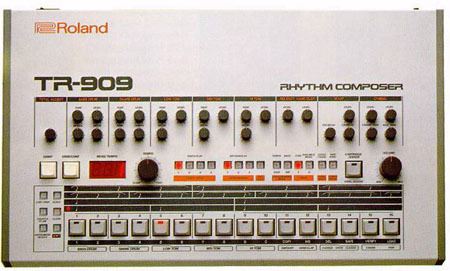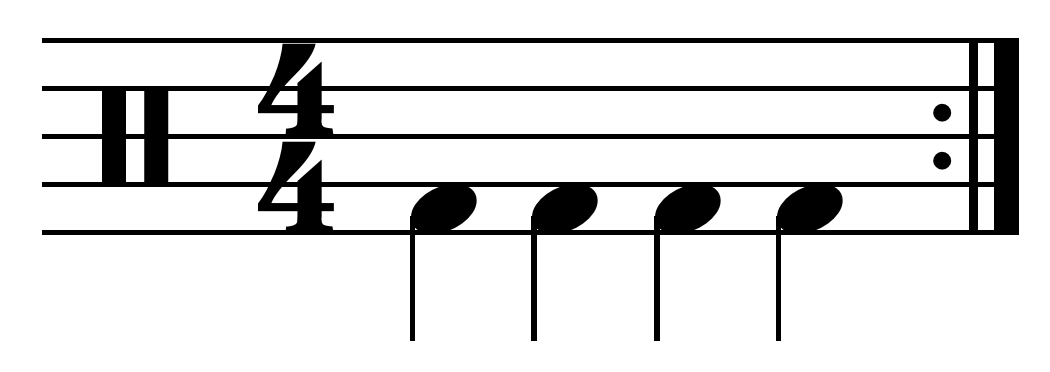|
Roland 909
The Roland TR-909 Rhythm Composer, commonly known as the 909, is a drum machine introduced by Roland Corporation in 1983, succeeding the TR-808. It was the first Roland drum machine to use samples for some sounds, and the first with MIDI functionality, allowing it to synchronize with other devices. Though the 909 was a commercial failure, it influenced the development of electronic dance music genres such as techno, house and acid house. Development The TR-909 was designed by Tadao Kikumoto, who had also led development on Roland's previous drum machine, the TR-808, and designed the Roland TB-303 synthesizer. Makoto Muroi was also a chief engineer, the software was developed by Atsushi Hoshiai, and the voice circuits were developed by Yoshiro Oue. The 909 was the first Roland drum machine to use samples, for its crash, ride and hi-hat sounds. Hoshiai sampled his own drum kit for the cymbals, using a mismatched pair of Paiste and Zildjian hi-hat cymbals. He sampled them i ... [...More Info...] [...Related Items...] OR: [Wikipedia] [Google] [Baidu] |
Roland Corporation
is a Japanese multinational manufacturer of electronic musical instruments, electronic equipment, and software. It was founded by Ikutaro Kakehashi in Osaka on 18 April 1972. In 2005, its headquarters relocated to Hamamatsu in Shizuoka Prefecture. It has factories in Malaysia, Taiwan, Japan, and the United States. As of December 2022, it employed 2,783 people. In 2014, it was subject to a management buyout by its CEO, Junichi Miki, supported by Taiyo Pacific Partners. Roland has manufactured numerous instruments that have had lasting impacts on music, such as the Juno-106 synthesizer, TB-303 bass synthesizer, and TR-808 and TR-909 drum machines. It was also instrumental in the development of MIDI, a standardized means of synchronizing electronic instruments manufactured by different companies. In 2016, ''Fact'' wrote that Roland had arguably had more influence on electronic music than any other company. History Background Roland founder Ikutaro Kakehashi had founded ... [...More Info...] [...Related Items...] OR: [Wikipedia] [Google] [Baidu] |
Tadao Kikumoto
is Roland's senior managing director and head of its R&D center. He designed the TB-303 bass synthesizer and the TR-909 drum machine. He was also the chief engineer of the Roland TR-808 drum machine. Roland TR-808 Design The Roland TR-808, a programmable drum machine, was launched in 1980. The TR-808 included unique artificial percussion sounds, such as “the hum kick, the ticky snare, the tishy hi-hats (open and closed) and the spacey cowbell.” The machine is particularly noted for its powerful booming bass drum sound, built from a combination of a bridged T-network sine oscillator, a low-pass filter, and a voltage-controlled amplifier. The bass drum decay control allows the user to lengthen the sound, creating uniquely low frequencies that flatten slightly over long periods, which can be used to create basslines or bass drops.'' Spin''February 1990, page 24/ref> It was the first drum machine with the ability to program an entire percussion track of a song from begi ... [...More Info...] [...Related Items...] OR: [Wikipedia] [Google] [Baidu] |
Bass Drum
The bass drum is a large drum that produces a note of low definite or indefinite pitch. The instrument is typically cylindrical, with the drum's diameter usually greater than its depth, with a struck head at both ends of the cylinder. The heads may be made of calfskin or plastic and there is normally a means of adjusting the tension, either by threaded taps or by strings. Bass drums are built in a variety of sizes, but size does not dictate the volume produced by the drum. The pitch and the sound can vary much with different sizes,Norman Del Mar, Del Mar, Norman (1981). ''Anatomy of the Orchestra''. . but the size is also chosen based on convenience and aesthetics. Bass drums are percussion instruments that vary in size and are used in several musical genres. Three major types of bass drums can be distinguished. * The type usually seen or heard in orchestral, ensemble or concert band music is the orchestral, or concert bass drum (in Italian: gran cassa, gran tamburo). It is the ... [...More Info...] [...Related Items...] OR: [Wikipedia] [Google] [Baidu] |
Polyphony And Monophony In Instruments
Polyphony is a property of musical instruments that means that they can play multiple independent melody lines simultaneously. Instruments featuring polyphony are said to be polyphonic. Instruments that are not capable of polyphony are monophonic or paraphonic. An intuitively understandable example for a polyphonic instrument is a (classical) piano, on which the player plays different melody lines with the left and the right hand - depending on music style and composition, these may be musically tightly interrelated or may even be totally unrelated to each other, like in parts of Jazz music. An example for monophonic instruments is a trumpet which can generate only one tone (frequency) at a time, except when played by extraordinary musicians. Synthesizer Monophonic A monophonic synthesizer or ''monosynth'' is a synthesizer that produces only one note at a time, making it smaller and cheaper than a polyphonic synthesizer which can play multiple notes at once. This does not ne ... [...More Info...] [...Related Items...] OR: [Wikipedia] [Google] [Baidu] |
Complex (website)
Complex Networks is an American media and entertainment company for youth culture, based in New York City. It was founded as a bi-monthly magazine, ''Complex'', by fashion designer Marc Eckō. Complex Networks reports on popular and emerging trends in style, sneakers, food, music, sports and pop culture. Complex Networks reached over 90 million unique users per month in 2013 across its owned and operated and partner sites, socials and YouTube channels. The print magazine ceased publication with the December 2016/January 2017 issue. Complex currently has 6.02 million subscribers and 1.8 billion total views on YouTube. the company's yearly revenue was estimated to be US$200 million, 15% of which came from commerce. Complex Networks has been named by ''Business Insider'' as one of the Most Valuable Startups in New York, and Most Valuable Private Companies in the World. In 2012, the company launched Complex TV, an online broadcasting platform. In 2016, it became a joint-venture o ... [...More Info...] [...Related Items...] OR: [Wikipedia] [Google] [Baidu] |
Fact (UK Magazine)
''Fact'' is a music publication that launched in the UK in 2003. It covers UK, US, and international music and youth culture topics, with particular focus on electronic, pop, rap, and experimental artists. Having started as a bi-monthly print magazine, ''Fact'' went digital in 2008, focusing on its website and online TV channel ''Fact TV'', which produces documentaries and videos including the series ''Against the Clock''. In November 2020 it returned to publishing a bi-annual print magazine. ''Fact'' produces weekly Fact Mixes. It previously produced the Singles Club review series, and Make Music, aimed at inspiring producers and bedroom musicians. ''Fact'' operates out of a London office, with additional full-time staff in Los Angeles and New York City. It is part of The Vinyl Factory group. History ''Fact'' was founded in 2003 as a print magazine. It commissioned covers by artists including M.I.A., Bat for Lashes, Shepard Fairey, Barry McGee, Peter Saville, T ... [...More Info...] [...Related Items...] OR: [Wikipedia] [Google] [Baidu] |
909 House Pattern
9 (nine) is the natural number following and preceding . Evolution of the Hindu–Arabic digit Circa 300 BC, as part of the Brahmi numerals, various Indians wrote a digit 9 similar in shape to the modern closing question mark without the bottom dot. The Kshatrapa, Andhra and Gupta started curving the bottom vertical line coming up with a -look-alike. How the numbers got to their Gupta form is open to considerable debate. The Nagari continued the bottom stroke to make a circle and enclose the 3-look-alike, in much the same way that the sign @ encircles a lowercase ''a''. As time went on, the enclosing circle became bigger and its line continued beyond the circle downwards, as the 3-look-alike became smaller. Soon, all that was left of the 3-look-alike was a squiggle. The Arabs simply connected that squiggle to the downward stroke at the middle and subsequent European change was purely cosmetic. While the shape of the glyph for the digit 9 has an ascender in most modern typefa ... [...More Info...] [...Related Items...] OR: [Wikipedia] [Google] [Baidu] |
CP/M
CP/M, originally standing for Control Program/Monitor and later Control Program for Microcomputers, is a mass-market operating system created in 1974 for Intel 8080/Intel 8085, 85-based microcomputers by Gary Kildall of Digital Research, Digital Research, Inc. CP/M is a disk operating system and its purpose is to organize files on a magnetic storage medium, and to load and run programs stored on a disk. Initially confined to single-tasking on 8-bit processors and no more than 64 kilobytes of memory, later versions of CP/M added multi-user variations and were migrated to 16-bit processors. CP/M's core components are the ''Basic Input/Output System'' (BIOS), the ''Basic Disk Operating System'' (BDOS), and the ''Console Command Processor'' (CCP). The BIOS consists of drivers that deal with devices and system hardware. The BDOS implements the file system and provides system services to applications. The CCP is the command-line interpreter and provides some built-in commands. CP ... [...More Info...] [...Related Items...] OR: [Wikipedia] [Google] [Baidu] |
Waveform
In electronics, acoustics, and related fields, the waveform of a signal is the shape of its Graph of a function, graph as a function of time, independent of its time and Magnitude (mathematics), magnitude Scale (ratio), scales and of any displacement in time.David Crecraft, David Gorham, ''Electronics'', 2nd ed., , CRC Press, 2002, p. 62 ''Periodic waveforms'' repeat regularly at a constant wave period, period. The term can also be used for non-periodic or aperiodic signals, like chirps and pulse (signal processing), pulses. In electronics, the term is usually applied to time-varying voltages, electric current, currents, or electromagnetic fields. In acoustics, it is usually applied to steady periodic sounds — variations of air pressure, pressure in air or other media. In these cases, the waveform is an attribute that is independent of the frequency, amplitude, or phase shift of the signal. The waveform of an electrical signal can be visualized with an oscilloscope or an ... [...More Info...] [...Related Items...] OR: [Wikipedia] [Google] [Baidu] |
Audio Bit Depth
In digital audio using pulse-code modulation (PCM), bit depth is the number of bits of information in each sample, and it directly corresponds to the resolution of each sample. Examples of bit depth include Compact Disc Digital Audio, which uses 16 bits per sample, and DVD-Audio and Blu-ray Disc, which can support up to 24 bits per sample. In basic implementations, variations in bit depth primarily affect the noise level from quantization error—thus the signal-to-noise ratio (SNR) and dynamic range. However, techniques such as dithering, noise shaping, and oversampling can mitigate these effects without changing the bit depth. Bit depth also affects bit rate and file size. Bit depth is useful for describing PCM digital signals. Non-PCM formats, such as those using lossy compression, do not have associated bit depths. Binary representation A PCM signal is a sequence of digital audio samples containing the data providing the necessary information to reconst ... [...More Info...] [...Related Items...] OR: [Wikipedia] [Google] [Baidu] |
Zildjian
The Avedis Zildjian Company, simply known as Zildjian (), is a musical instrument manufacturer specializing in cymbals and other percussion instruments. Founded by the ethnic Armenian Zildjian family in the 17th-century Ottoman Empire, the company relocated to the United States in the 20th century. Today, it is the largest cymbal and drumstick maker in the world. The company was founded in Constantinople in 1623 by Avedis Zildjian, an Armenian. Zildjian is now based in Norwell, Massachusetts. Zildjian is the oldest manufacturer of musical instruments in the world as well as one of the oldest continuously operating companies in the world. Zildjian sells cymbals, drumsticks, percussion mallets and other drum accessories under the Zildjian, Vic Firth and Balter Mallet brands. History Beginnings The first Zildjian cymbals were created in 1618 by Avedis Zildjian, an Armenian metalsmith and alchemist. Like his father, who was also a metalsmith, he worked for the court of the Su ... [...More Info...] [...Related Items...] OR: [Wikipedia] [Google] [Baidu] |
Paiste
Paiste (English pronunciation: , ) is a Switzerland, Swiss musical instrument manufacturing company. It is the world's third largest manufacturer of cymbals, gongs, and metal percussion. is an Estonian language, Estonian and Finnish language, Finnish word that means "shine". Apart from cymbals and gongs, Paiste has also manufactured other percussion instruments, including crotal bells, zill, finger cymbals, and cowbells, which were later discontinued. History The first Paiste cymbals were produced in 1906 by Estonian musician Toomas Paiste in his instrument repair shop in Saint Petersburg, Russian Empire. Toomas had served in the Imperial Guard (Russia), Russian Imperial Guard and retired in 1901 to open a music shop and publishing business.History on Paiste website, 07 Nov 2023 The cymba ... [...More Info...] [...Related Items...] OR: [Wikipedia] [Google] [Baidu] |





